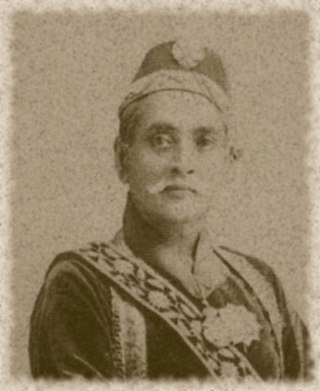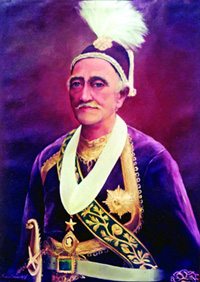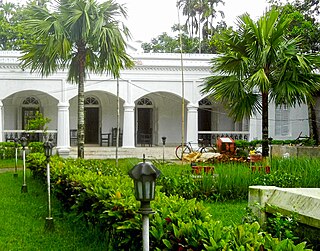
Sir Khawaja Nazimuddin was a Pakistani politician and one of the leading founding fathers of Pakistan. He is noted as being the first Bengali to have governed Pakistan, first as a Governor-General (1948–51), and later as a Prime Minister (1951–53).

Abul Kasem Fazlul Huq, popularly known as Sher-e-Bangla, was a Pakistani Bengali lawyer and politician who presented the Lahore Resolution which had the objective of creating an independent Pakistan. He also served as the first and longest Prime Minister of Bengal during the British Raj.

The first Partition of Bengal (1905) was a territorial reorganization of the Bengal Presidency implemented by the authorities of the British Raj. The reorganization separated the largely Muslim eastern areas from the largely Hindu western areas. Announced on 20 July 1905 by Lord Curzon, the then Viceroy of India, and implemented on 16 October 1905, it was undone a mere six years later. The nationalists saw the partition as a challenge to Indian nationalism and as a deliberate attempt to divide the Bengal Presidency on religious grounds, with a Muslim majority in the east and a Hindu majority in the west. The Hindus of West Bengal complained that the division would make them a minority in a province that would incorporate the province of Bihar and Orissa. Hindus were outraged at what they saw as a "divide and rule" policy, even though Curzon stressed it would produce administrative efficiency. The partition animated the Muslims to form their own national organization along communal lines. To appease Bengali sentiment, Bengal was reunited by Lord Hardinge in 1911, in response to the Swadeshi movement's riots in protest against the policy.

Shahbag or Shahbagh is a major neighbourhood and a police precinct or thana in Dhaka, the capital and largest city of Bangladesh. It is also a major public transport hub. It is a junction between two contrasting sections of the city—Old Dhaka and New Dhaka—which lie, respectively, to its south and north. Developed in the 17th century during Mughal rule in Bengal, when Old Dhaka was the provincial capital and a centre of the flourishing muslin industry, it came to neglect and decay in early 19th century. In the mid-19th century, the Shahbag area was developed as New Dhaka became a provincial centre of the British Raj, ending a century of decline brought on by the passing of Mughal rule.
The All India Muhammadan Educational Conference was an organisation promoting modern, liberal education for the Muslim community in India. It was founded by Sir Syed Ahmed Khan, also the founder of the Aligarh Muslim University. All India Mumammadan Educational Conference was the origin of the All-India Muslim League. The Muslim League was born in the 20th session of All India Muhammadan Educational Conference, which was established by Syed Ahmed Khan in Aligarh in 1886. Muhammadan Educational Conference used to hold its annual meetings in various cities where, by the co-operation of local Muslims, steps were taken for the progress of education.

Nawab Bahadur Sir Khwaja Ahsanullah KCIE was the third Nawab of Dhaka. He also authored books in Persian and Urdu under the pen name of Shaheen. Ahsanullah is recognised for his philanthropic works in Bengal, most notably his donations to the present Bangladesh University of Engineering and Technology.

Nawab Sir Khwaja Salimullah Bahadur was the fourth Nawab of Dhaka and one of the leading Muslim politicians during the British rule in India. In 1906, the Muslim League was officially founded at the educational conference held in Dhaka. The convention was held at Ahsan Manzil, the official residence of the Dhaka Nawab Family. Sir Salimullah was a key patron of education for the Eastern Bengal. He was one of the founders of the University of Dhaka and the prestigious Ahsanullah School of Engineering. Sir Salimullah was a staunch supporter of the Partition of Bengal and was a member of East Bengal and Assam Legislative Council from 1906 to 1907. He was also a member of Bengal Legislative Assembly from 1913 till his death in Calcutta in 1915 at the age of 43. He was the founder President of Bengal Muslim League in 1907.

Nawab Bahadur Sir Khwaja Abdul Ghani was the second Nawab of Dhaka and the first to assume the title of Nawab as hereditary, recognized by the British Raj.

Nawab Khwaja Habibullah Bahadur was the fifth Nawab of Dhaka. He was the son of Nawab Sir Khwaja Salimullah Bahadur. Under Habibullah's rule, the Dhaka Nawab Estate went into decline until its actual relinquishment in 1952 by the East Pakistan Estates Acquisition Act.

The Nawab of Dhaka, originally spelt in English Nawab of Dacca, was the title of the head of largest Muslim zamindar in British Bengal and Assam, based in present-day Dhaka, Bangladesh. The title of nawab, similar to the British peerage, was conferred upon the head of the family by Queen Victoria as a recognition of the first Nawab's loyalty and contribution to the social welfare activities.

The University of Dhaka was established in 1921 as the first university in East Bengal. Following demands from Nawab Sir Khwaja Salimullah Bahadur and others, Viceroy Lord Hardinge proposed on 2 February 1912, that a new university should be established in this partition of Bengal.
Nawab Major Khwaja Hassan Askari, was the sixth and last Nawab of Dhaka. He was born at the Ahsan Manzil Palace in Dhaka. He was the eldest son of Nawab Habibullah Bahadur and Shahryar Begum. He became the Nawab of Dhaka after his father's death in 1958.

Israt Manzil was one of the royal residences of the Nawabs of Dhaka. The mansion served as a retreat for members of the Dhaka Nawab Family.

The University of Dhaka is a public collegiate research university located in Dhaka, Bangladesh. It is the oldest university in Bangladesh. The university opened its doors to students on July 1st, 1921. Currently it is the largest public research university in Bangladesh, with a student body of 46,150 and a faculty of 1,992.
Nawab Bahadur was a title of honour bestowed during Mughal Empire and later during British Raj to Indian Muslim individuals for faithful service or acts of public welfare.

Nawab Khan Bahadur Khwaja Yusuf Jan, was a Kashmiri-Bengali politician and member of Dhaka Nawab family.

Syed Abdul Majid, CIE, also known by his nickname Kaptan Miah, was a politician, lawyer and entrepreneur. He is notable for pioneering the development in the agricultural and tea industry in British India as well as his contributions to both secular and Islamic education in Sylhet.

The Maulvi family, better known as the family of Jitu Miah, were a wealthy Bengali Muslim jagirdar family of Maulvis based in Sylhet. They played important religious and political roles in the history of Sylhet, Bengal and the subcontinent. Jitu Miah, the last jagirdar of the family, died in 1925 without leaving behind an heir. However the family estate managed by the local government, continued to be a prominent landmark in the town and a legacy of the family.
Dewan Taimur Raja Chowdhury was a Bangladesh Nationalist Party politician, landowner and poet. He was the former member of parliament from Sylhet-7.
The Sardari system refers to the panchayat system used in the city of Dhaka from the second half of the nineteenth century. The system developed during under the Nawabs of Dhaka. In this state-recognised practice, a five-member committee was formed in each mahalla of the city, consisting of local influential Muslims who would take care of the minor issues of the mahalla. The chief of the mahalla committee was referred to as the Sardar. The Sardar was appointed for life, and after his death, his son was usually the next Sardar. The Nawab of Dhaka used to give approval and formal recognition to the family panchayat committee.
















